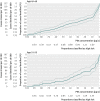Strategy for detection of prostate cancer based on relation between prostate specific antigen at age 40-55 and long term risk of metastasis: case-control study
- PMID: 23596126
- PMCID: PMC3933251
- DOI: 10.1136/bmj.f2023
Strategy for detection of prostate cancer based on relation between prostate specific antigen at age 40-55 and long term risk of metastasis: case-control study
Abstract
Objective: To determine the association between concentration of prostate specific antigen (PSA) at age 40-55 and subsequent risk of prostate cancer metastasis and mortality in an unscreened population to evaluate when to start screening for prostate cancer and whether rescreening could be risk stratified.
Design: Case-control study with 1:3 matching nested within a highly representative population based cohort study.
Setting: Malmö Preventive Project, Sweden.
Participants: 21,277 Swedish men aged 27-52 (74% of the eligible population) who provided blood at baseline in 1974-84, and 4922 men invited to provide a second sample six years later. Rates of PSA testing remained extremely low during median follow-up of 27 years.
Main outcome measures: Metastasis or death from prostate cancer ascertained by review of case notes.
Results: Risk of death from prostate cancer was associated with baseline PSA: 44% (95% confidence interval 34% to 53%) of deaths occurred in men with a PSA concentration in the highest 10th of the distribution of concentrations at age 45-49 (≥ 1.6 µg/L), with a similar proportion for the highest 10th at age 51-55 (≥ 2.4 µg/L: 44%, 32% to 56%). Although a 25-30 year risk of prostate cancer metastasis could not be ruled out by concentrations below the median at age 45-49 (0.68 µg/L) or 51-55 (0.85 µg/L), the 15 year risk remained low at 0.09% (0.03% to 0.23%) at age 45-49 and 0.28% (0.11% to 0.66%) at age 51-55, suggesting that longer intervals between screening would be appropriate in this group.
Conclusion: Measurement of PSA concentration in early midlife can identify a small group of men at increased risk of prostate cancer metastasis several decades later. Careful surveillance is warranted in these men. Given existing data on the risk of death by PSA concentration at age 60, these results suggest that three lifetime PSA tests (mid to late 40s, early 50s, and 60) are probably sufficient for at least half of men.
Conflict of interest statement
Competing interests: All authors have completed the ICMJE uniform disclosure form at
Figures
Comment in
-
Still not enough evidence to support screening based on prostate specific antigen.BMJ. 2013 May 28;346:f3388. doi: 10.1136/bmj.f3388. BMJ. 2013. PMID: 23716489 No abstract available.
-
Prostate cancer: the growing evidence supporting mid-life PSA testing.Nat Rev Urol. 2013 Aug;10(8):436-8. doi: 10.1038/nrurol.2013.144. Epub 2013 Jul 2. Nat Rev Urol. 2013. PMID: 23817409 No abstract available.
-
Words of wisdom: Re: Strategy for detection of prostate cancer based on relation between prostate specific antigen at age 40-55 and long term risk of metastasis: case-control study.Eur Urol. 2013 Oct;64(4):681-2. doi: 10.1016/j.eururo.2013.07.015. Eur Urol. 2013. PMID: 23998499 No abstract available.
References
-
- Stenman UH, Hakama M, Knekt P, Aromaa A, Teppo L, Leinonen J. Serum concentrations of prostate specific antigen and its complex with alpha 1-antichymotrypsin before diagnosis of prostate cancer. Lancet 1994;344:1594-8. - PubMed
-
- Gann PH, Hennekens CH, Stampfer MJ. A prospective evaluation of plasma prostate-specific antigen for detection of prostatic cancer. JAMA 1995;273:289-94. - PubMed
-
- Lilja H, Ulmert D, Bjork T, Becker C, Serio AM, Nilsson JA, et al. Long-term prediction of prostate cancer up to 25 years before diagnosis of prostate cancer using prostate kallikreins measured at age 44 to 50 years. J Clin Oncol 2007;25:431-6. - PubMed
Publication types
MeSH terms
Substances
Grants and funding
LinkOut - more resources
Full Text Sources
Other Literature Sources
Medical
Research Materials
Miscellaneous


